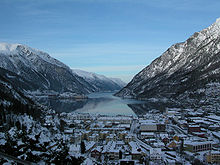Odda
Odda is a place and a former municipality in the Norwegian province ( Fylke ) Hordaland (2020 part of Vestland become). As part of the municipal reform in Norway , Odda and Jondal were merged with Ullensvang on January 1, 2020 . 6,745 inhabitants lived in the municipality on an area of 1674 km² (as of January 1, 2019). The municipality number was 1228. The last mayor was Roald Aga Haug ( Ap ).
The town of Odda is the secret capital of Hardanger and is located at the inner end of the Sørfjord , a branch of the Hardangerfjord that cuts deep into the 1200-1300 m high mountains , framed by the Folgefonna glacier and the steep mountain slopes of the Hardangervidda .
The main settlement of Odda, together with its neighboring towns of Tyssedal and Eitrheimsnes, is a heavy industry site, the smoking chimneys of which have shaped the reputation of Odda in recent years. Although most travel guides don't particularly recommend Odda, Norway's natural beauty has been preserved away from the industrial region around Odda.
history
Around 1900 Odda was the favorite destination of wealthy summer visitors to the fjord country, and at times even the most visited. Sun visited Kaiser Wilhelm every summer from 1891 to 1914 Odda; he was followed by a long line of European princes and kings.
In 1906 the groundbreaking ceremony for the Tyssedal hydropower plant Tysso I (completed in 1908) took place in order to supply the burgeoning carbide and cyanamide factories in the center of Odda with electrical energy. The carbide factory, whose production started accordingly in 1908, was the largest in the world at the time.
Within three to four years, the population of Tyssedal rose from 30 to 1,000 and in Odda from 600 to 4,000, both industrial locations only six kilometers apart.
With the outbreak of the First World War in 1914, the exclusive rural idyll of the year-round ice-free fjord was finally over.
In 1927 Erling Johnson invented a process for the production of fertilizers in the smelting plant ( Odda Smelteverk ) . This manufacturing process is known as the Odda process .
In 1970 the Sørfjord hit the headlines again because it was so heavily polluted by the waste products of heavy industry that it was foreseeable that all living things in the fjord would perish. It was the most heavy metal fjord in the world. An environmental protection committee was founded which, with the support of politics, business and science, looked for new ways to produce more environmentally friendly heavy metals. Since the mid-1980s, a large part of the waste products has been deposited in halls inside the mountain.
In 2003 the Odda Smelteverk filed for bankruptcy.
traffic
The Folgefonnatunnel has been connecting Odda with the municipality of Kvinnherad since 2001 . The European route 134 ( Haukelivegen ) passes Røldal . This road leads over the Haukelifjell and connects the western part of the country ( Vestlandet ) with the eastern part ( Østlandet ). The route has many tunnels and is therefore open all year round.
Sights of the municipality
The industrial museum is located in Odda itself and provides information on the eventful history of Odda from 1850 to the present day.
Låtefoss waterfall is located about 15 km south of Odda directly on road 13.
The idyllic Buartal, southwest of Odda, provides access to Buarbreen , part of the Folgefonna Glacier.
In Tyssedal, six km north on the east bank of the Sørfjord, is the listed building of the Tisso I hydroelectric power station, which was in operation until 1996 and has now been converted into a museum (see also under History), an anchor point on the European Route of Industrial Culture . The Ringedalsvatn reservoir is located above Tyssedal in Skjeggedal. The Trolltunga (in German "Troll's Tongue") above the Ringedalsvatn is a popular destination for mountain hikers (22 km, 900 meters difference in altitude), but due to its degree of difficulty it often leads to rescue operations.
In Røldal there is a stave church built around 1200–1250 , which developed into a well-known pilgrimage destination in the 14th century . There is also a popular ski area with a ski lift in Røldal.
The Agatunet open-air museum is located north of Odda .
literature
The novelistic novel Bikubesong (1999) by the author Frode Grytten, which has won several awards , is set in Odda. Grytten portrays fictional people from the so-called Murboligen , a workers' block in the center of Odda. The book has also been translated into German. In the meantime Frode Grytten has written another book with Odda as the setting.
People connected to Odda Municipality
- Knud Knudsen (1832–1915), photographer and pomologist
- Gro Holm (1878-1951), author
- Erling Johnson (1893–1967), chemist and developer of the Odda process
- Claes Gill (1910–1973), poet
- Anne B. Ragde (* 1957), writer
- Frode Grytten (* 1960), author and journalist
- Børge Brende (* 1965), politician and Minister of Foreign Affairs of Norway since 2013
- Ingvill Måkestad Bovim (* 1981), track and field athlete
- Håkon Opdal (* 1982), football player
Web links
Individual evidence
- ↑ Navn på nye kommuner. February 19, 2019, accessed October 1, 2019 (Norwegian).
- ↑ Elizabeth Bjørsvik: The TICCIH Section for hydroelectricity and the electrochemical industry: Industrial heritage in Norway as in Example , in: Le patrimoine industriel de l'Electricité et de l'hydroélectricité . Eds. Denis Varaschin and Yves Bouvier, University of Savoy , December 2009, ISBN 978-2-915797-59-6 , p. 112
- ↑ Odda and the Valley of the Waterfalls , section on the smelting works in Odda
Coordinates: 60 ° 4 ′ N , 6 ° 33 ′ E


